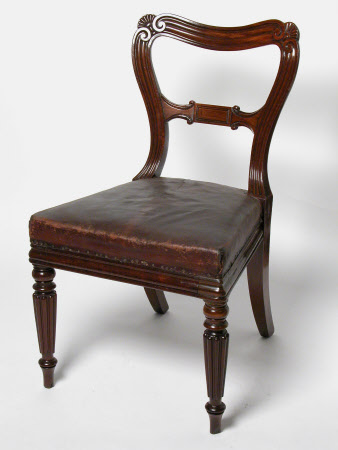Chair
Gillow & Co.
Category
Furniture
Date
1827
Materials
Mahogany, beech, leather
Measurements
86 x 49.5 x 46 cm
Place of origin
Lancaster or London
Order this imageCollection
Erddig, Wrexham
NT 1147044.11
Summary
A chair, one of a set of twenty-two mahogany chairs, by Gillow & Co., the craftsman probably T(homas?) Bradley. Given to Simon Yorke II (1771–1834) and his wife Margaret Holland (1778–1848) by her brother, John Holland, as a present, possibly to mark the occasion of their twentieth wedding anniversary. They cost £110, 5s, 4d and were acquired in December 1827. The set comprising twenty standard chairs and two open armchairs [the latter NT 1147044.21 - .22]. Having a waisted and moulded back; the toprail slightly concave and carved with scrolls and at its corners with fans. The horizontal moulded splat centred by a tablet between scrolls. The seat stuff-over and upholstered in original dark red Morocco leather above moulded seat rails. The front legs turned, tapering and reeded; the rectangular-section rear legs outswept. -- An identical chair is drawn in Gillows' 1823 sketch book. These chairs bear a variety of marks, made in a variety of media. This example is stamped 'T. BRADLEY'. Others are signed 'J. Hayward' in pencil and it also bears the inscription 'Yorke' - for the buyer - also in pencil. Thomas Bradley's stamp is known on other early 19th-century chairs, such as a set of nine made for Thomas John Wynn (d. 1832), 2nd Baron Newborough, of Glynillifon, Caernarvonshire, Wales in 1823. Two of this set also bore pencil inscriptions and the stamped initials 'M.B' and 'M'.
Provenance
Acquired December 1827 for £110.5.4. Thence by descent until given by Phillip Yorke III (1905-1978) along with the estate, house and contents to the National Trust in 1973.
Marks and inscriptions
Rear seat rail: T. BRADLEY
Makers and roles
Gillow & Co., designer Thomas Bradley (fl.1827), maker Gillow & Co., retailer
References
Stuart, Susan 'Gillows of Lancaster and London 1730 - 1840' (2008) 2 vols., Vol. I, p. 221, Plate 204 Vol. II, p. 221
